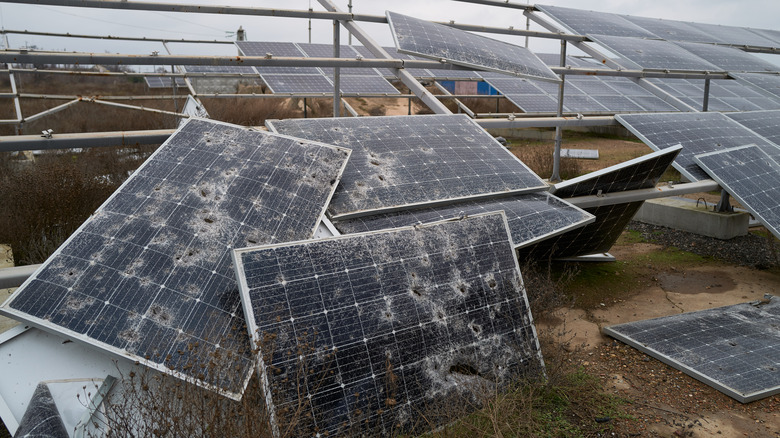
Pierre Crom/Getty Images
On March 15, 2024, thousands of solar panels installed at the 3,300-acre Fighting Jays Solar Farm in Fort Bend County, Houston, Texas, were damaged after a powerful hailstorm hit the area. Even as authorities continue to assess the scale of damage caused by this extreme weather event, the incident — once again — highlighted one of the major risks people need to contend with while setting up solar power systems.
The March 15 incident is not the first time we have heard of hailstorms causing massive damage to solar panels in Texas. In 2019, the Midway Solar farm in West Texas was impacted by a severe hailstorm, causing estimated damage worth $70 million. Needless to say, people intending to set up their solar power system — especially in areas prone to intense hailstorms — need to keep this factor in mind before plonking their hard-earned money on such a capital-intensive endeavor.
While solar panels are built to withstand light to moderate hailstorm events, in light of recent events, it is becoming increasingly clear that some damage may be inevitable in areas prone to intense hailstorms. Despite this, there are several steps one could take to protect solar panels from getting damaged by hail in the first place. Let us explore some of these options.
Buy solar panels with the highest impact protection rating
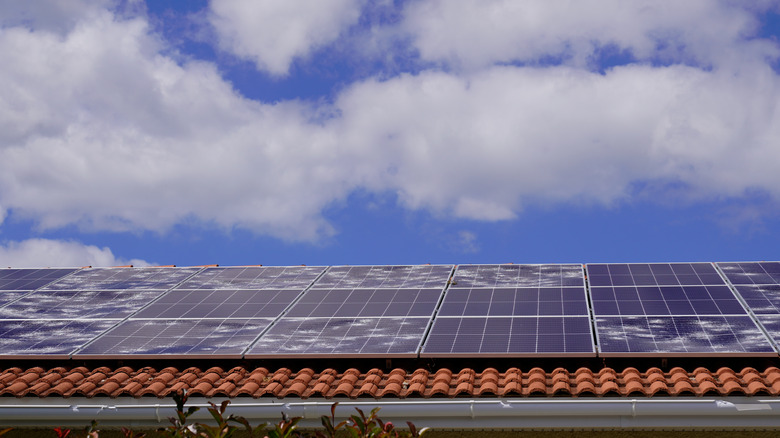
Oceanprod/Getty Images
If you are setting up a solar panel system and also happen to live in an area prone to intense hailstorms, you must invest in solar panels that are rated to withstand the most intense of hailstorms. As of 2024, solar panels that feature the highest level of impact protection boast of UL 61730 or IEC 61370 rating.
Solar panels with either of these ratings are designed to withstand hailstones ranging between 1 and 3 inches. The rating also takes into account the speed at which these hailstones impact the panel. To be IEC 61370 or UL 61370 rated, solar panels should survive an impact caused by a hailstone up to 3 inches in size while traveling at speeds of up to 88.3 mph.
If you invest in a solar panel that features either impact protection ratings, there is a greater chance that these would survive the worst hailstorms. There is no denying that these high-quality panels will be more expensive compared to other options in the market. However, the safety net provided by these panels in terms of impact and damage protection, does make them an attractive proposition.
It is vital to note that not everyone needs this level of impact protection, especially if they live in areas not known for intense hailstorms. According to data from the National Oceanic and Atmospheric Administration (NOAA), only some parts of Kansas, Nebraska, Oklahoma, and Texas are prone to hail stones that reach these sizes.
Apply a layer of Methacrylate to solar panels
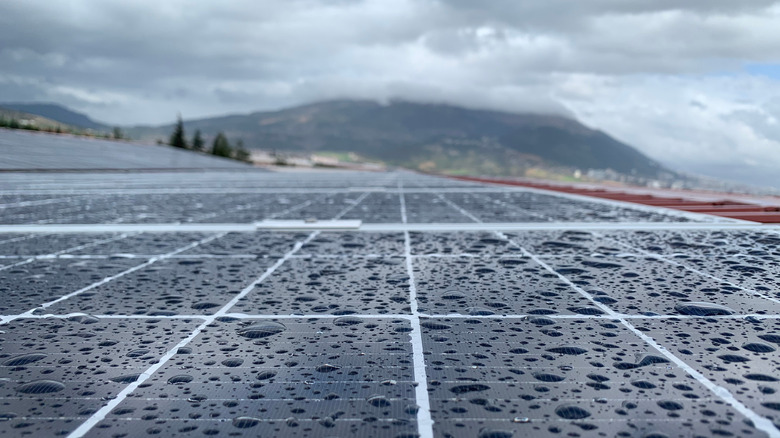
ksvaj/Shutterstock
In case you have an older solar panel installation and aren’t entirely sure about the impact protection rating for the panels used on your system, applying a layer of a chemical called methacrylate could offer some degree of added protection against hailstones. This chemical has long been dubbed as an inexpensive solution for people seeking improved impact protection for solar panels.
However, it is important to note that the decision to apply this layer of chemical should only be taken after you had a word with your solar panel vendor, with which you may already be in touch for your regular solar panel maintenance needs. Unless you are an expert and know what you’re doing, it is best you leave the application of methacrylate to experts. Incorrect or excess application of this chemical may have adverse effects on the panel’s ability to absorb sunlight, leading to reduced power generation.
Even if you are comfortable doing this on your own, it would be a wise idea to consult your vendor about any possible warranty implications. In case adding a layer of methacrylate to your solar panel installation is impractical and not feasible, it is time to move on to other methods — some of which may not exactly look sophisticated.
Adopt hail netting technique using wire mesh protectors
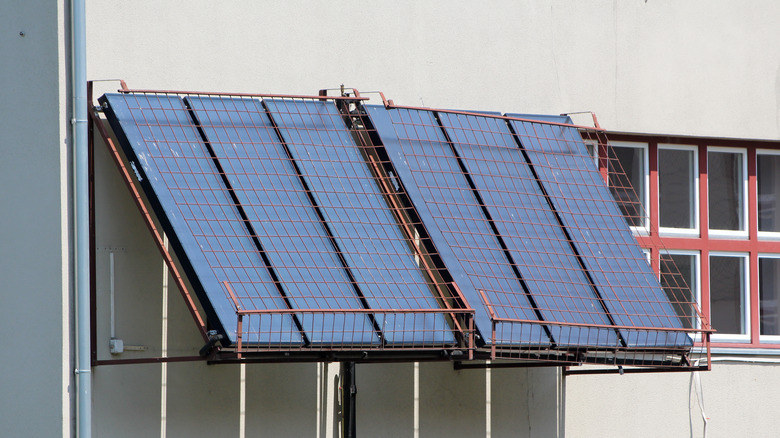
Hecos/Shutterstock
Often, the most effective protection against hailstorms is among the simplest. Instead of opting for a crude, makeshift solar panel protection solution, it may be a good idea to explore the advantages of installing a wire mesh solar panel protector. Known as hail netting, this solution constructs a near-transparent protective layer around the solar panels using wire mesh.
Hail netting is a relatively inexpensive solution, and its installation entails customizing a wire mesh to be fixed around the solar panels powering your home/office. Again, unless you have extensive experience installing solar power systems and working with delicate solar panels, it is best that you avail services of a solar company to set up a wire mesh solar protector system. Getting it installed by a professional shall ensure that the solution works as intended and acts as a physical barrier that prevents the larger-sized hailstones — known for causing the most damage — from impacting the solar panels.
Note that hail netting may still allow smaller-sized hailstones to breach the protection layer and hit the panels anyway. Another concern surrounding this technique is the fact that the presence of a net — however small — around the panels may slightly impact the panel’s ability to generate solar power.
DIY solutions and stowing solar panels
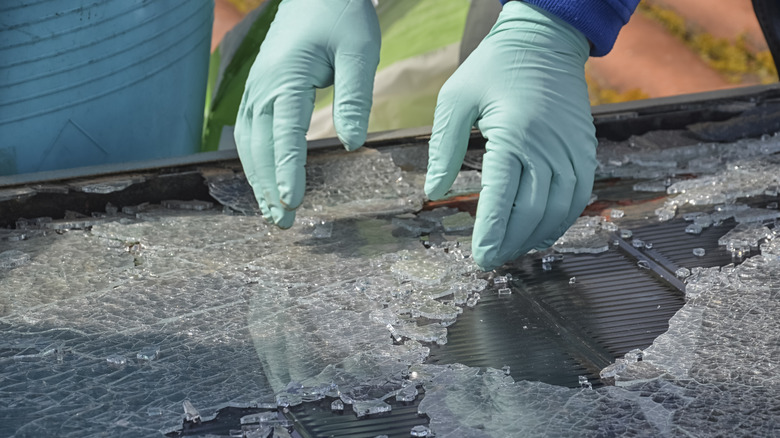
Lineas 1703/Getty Images
Before we conclude this article, let us reiterate that most modern-day solar panels are designed to withstand some degree of inclement weather. Hailstorms — due to their inherent capability to directly impact their surface — perhaps pose the biggest threat to solar panels.
Still, you are only required to opt for most of the aforementioned solar panel protection solutions if you live in an area prone to extremely heavy hailstones. If you do live in such an area and intend to set up a solar power system, it would be wise to design a system capable of stowing solar panels in a safer position if there is a threat of an impending hailstorm.
Stowing solar panels entails adjusting the angle of the entire solar panel assembly into a position in which the chances of a direct hit from hailstones are minimized. Unfortunately, setting up such a system could prove difficult on roofs, could also end up being more expensive, and is generally not preferred for small-scale home installations.
Another way of dealing with this problem is to engineer a dedicated solar panel protection canopy that can be either moved or removed once the threat of a hailstorm passes. This may be a practical and long-term solution to the problem. However, setting up such a system depends on several local factors, and you may be required to get in touch with your solar power system vendor for help. Not to mention, protecting your solar panels is only one of the hidden costs you should know about.